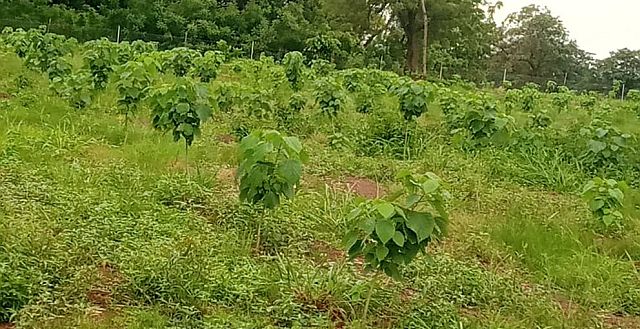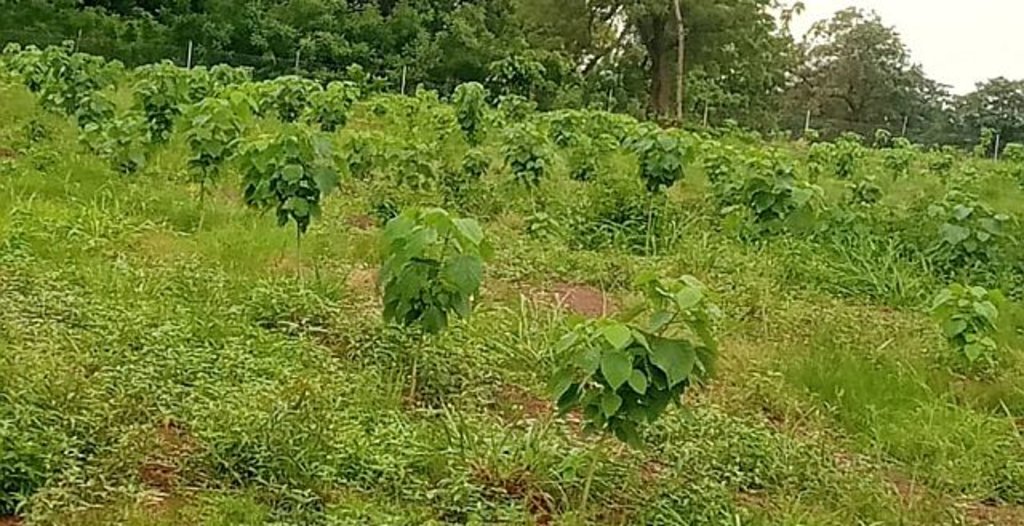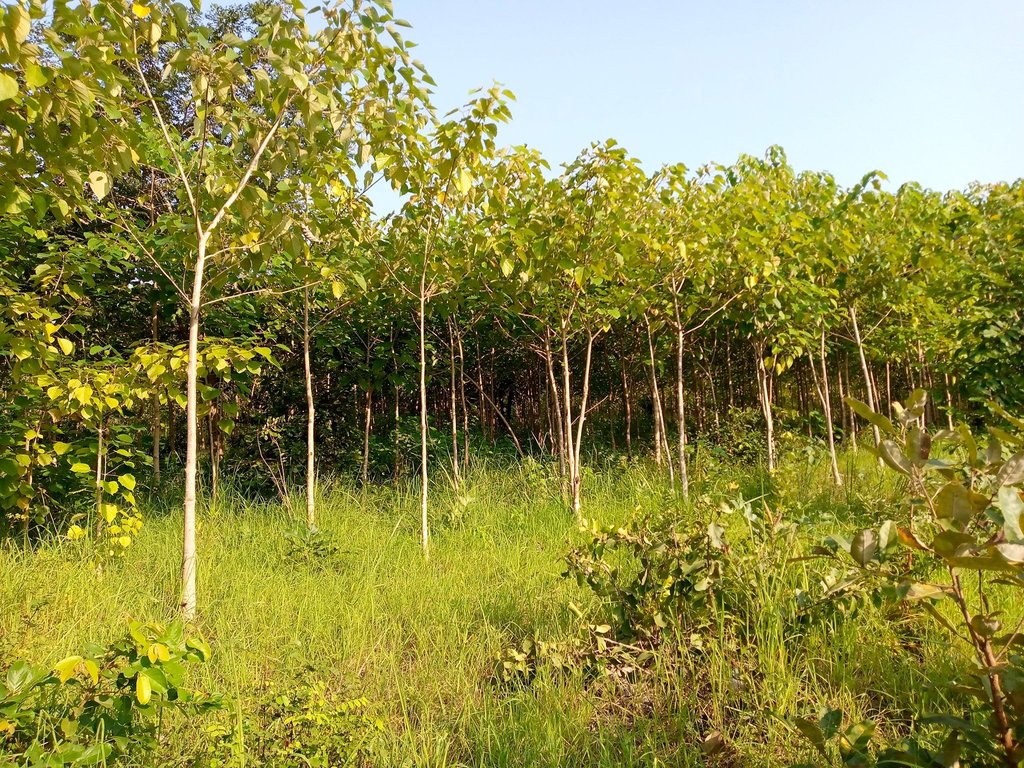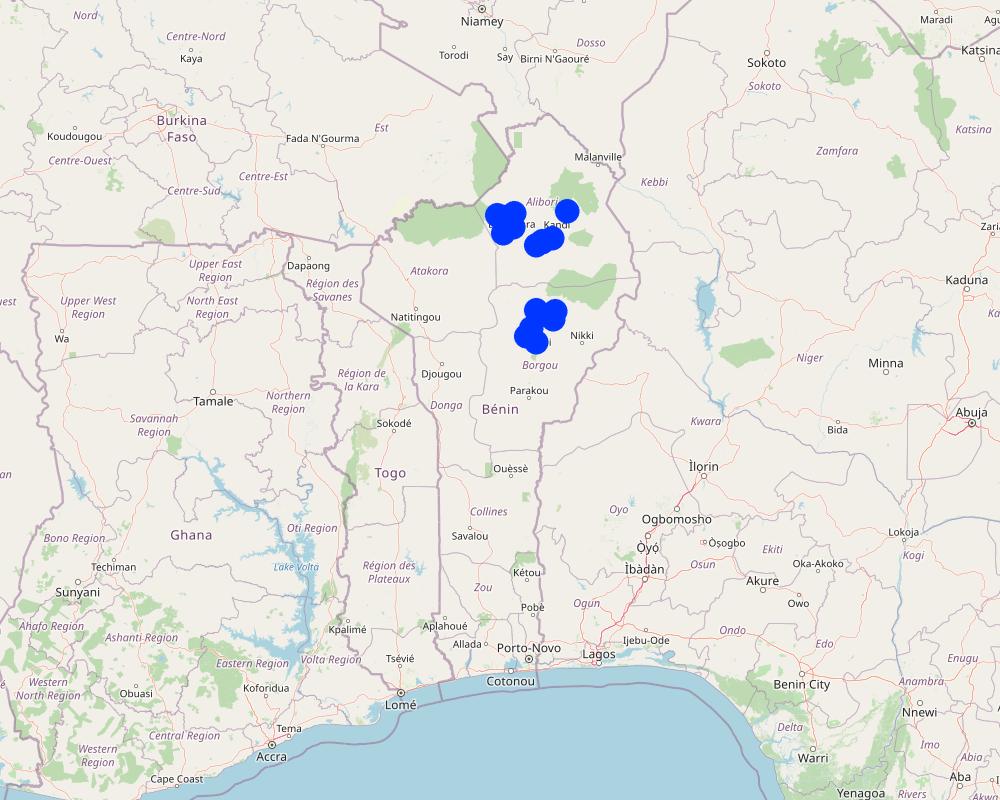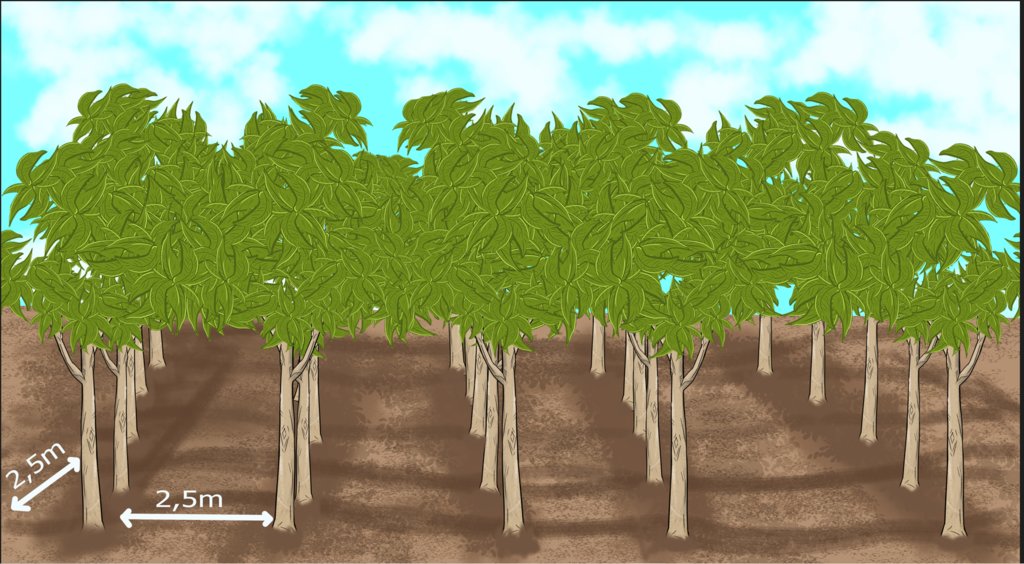Gmelina-Based Agroforestry [Benin]
- Creation:
- Update:
- Compiler: Gatien AGBOKOUN CHRISTOPHE
- Editors: Siagbé Golli, Abdoul Karim MIEN, DOSSOU-YOVO bernardin, Oscar Assa KINDEMIN, Bona Ibouratou DAFIA, Tabitha Nekesa, Ahmadou Gaye
- Reviewers: Sally Bunning, Rima Mekdaschi Studer, William Critchley
Fofitin
technologies_6672 - Benin
View sections
Expand all Collapse all1. General information
1.2 Contact details of resource persons and institutions involved in the assessment and documentation of the Technology
Key resource person(s)
SLM specialist:
ADJOKPALO Charles
ANaF Bénin
Benin
land user:
MEDONVE Germain
ANaF
Benin
Name of project which facilitated the documentation/ evaluation of the Technology (if relevant)
Soil protection and rehabilitation for food security (ProSo(i)l)Name of the institution(s) which facilitated the documentation/ evaluation of the Technology (if relevant)
GIZ Bénin (GIZ Bénin) - Benin1.3 Conditions regarding the use of data documented through WOCAT
The compiler and key resource person(s) accept the conditions regarding the use of data documented through WOCAT:
Yes
1.4 Declaration on sustainability of the described Technology
Is the Technology described here problematic with regard to land degradation, so that it cannot be declared a sustainable land management technology?
No
2. Description of the SLM Technology
2.1 Short description of the Technology
Definition of the Technology:
Gmelina trees as a basis for an agroforestry system help increase the soil's organic matter content, foster associated biodiversity, optimize the hydrological cycle, mitigate soil erosion, and generate income.
2.2 Detailed description of the Technology
Description:
Gmelina arborea trees are used in agroforestry systems. This technology serves multiple purposes, including:
- Restoring and preserving soil fertility
- Enhancing the microclimate
- Mitigating soil erosion and degradation caused by runoff water
- Reducing the soil's reliance on mineral fertilizers
- Acting as a windbreak to mitigate damage from strong winds
The planting process begins with clearing, staking and drilling. The seedlings are then planted at intervals of 2 m within rows and between 2.5 and 3 m between rows, resulting in a density of just over 1,000 seedlings per hectare.
To optimize the use of the plots where Gmelina seedlings are introduced, producers adopt the taungya system where seedlings are planted within annual crops like soybeans or maize. This approach offers the advantage of reducing initial plantation maintenance costs.
With respect to management procedures, weeding is conducted once or twice annually, and firebreaks are set up to mitigate the risk of bush fires. Additionally, clearing, pruning, and thinning operations are carried out. The thinning performed by producers reduces the number of trees per hectare to 750 and 450 for the first and second thinning respectively. They do so to leave the most vigorous trees standing for the production of economically valuable timber at the final cut. The harvests consist of poles.
The third and fourth thinning operations, which result in the production of logs (sawn timber and/or poles of various diameters), will take the plantation to around 250 and 150 trees per hectare respectively. It is worth noting that since the documented plantation was established, thinning has been carried out at intervals of 5 to 7 years, depending on the site's productivity index (soil production capacity).
For producers, the implementation of this technique generates several income-generating activities. These include both timber and non-timber products. Producers even install beehives.
2.3 Photos of the Technology
2.5 Country/ region/ locations where the Technology has been applied and which are covered by this assessment
Country:
Benin
Region/ State/ Province:
Collines
Further specification of location:
Savalou
Specify the spread of the Technology:
- evenly spread over an area
If precise area is not known, indicate approximate area covered:
- < 0.1 km2 (10 ha)
Is/are the technology site(s) located in a permanently protected area?
No
Map
×2.6 Date of implementation
Indicate year of implementation:
2016
2.7 Introduction of the Technology
Specify how the Technology was introduced:
- through projects/ external interventions
Comments (type of project, etc.):
It was popularized by the Soil Rehabilitation and Restoration Project financed by the German Cooperation Agency.
3. Classification of the SLM Technology
3.1 Main purpose(s) of the Technology
- reduce, prevent, restore land degradation
- conserve ecosystem
- preserve/ improve biodiversity
- mitigate climate change and its impacts
- create beneficial economic impact
3.2 Current land use type(s) where the Technology is applied
Land use mixed within the same land unit:
Yes
Specify mixed land use (crops/ grazing/ trees):
- Agroforestry

Cropland
- Annual cropping
- Tree and shrub cropping
Annual cropping - Specify crops:
- cereals - maize
- legumes and pulses - soya
- Gmelina arborea
Number of growing seasons per year:
- 1
Is intercropping practiced?
Yes
If yes, specify which crops are intercropped:
Maize is intercropped with Gmelina until the shade produced by the Gmelina is no longer suitable for maize cultivation.
Is crop rotation practiced?
Yes
If yes, specify:
Soya is rotated with maize.

Forest/ woodlands
- Tree plantation, afforestation
Tree plantation, afforestation: Specify origin and composition of species:
- Monoculture local variety
- Subtropical rainforest with Gmelina arborea
Type of tree:
- Gmelina arborea
Are the trees specified above deciduous or evergreen?
- evergreen
Products and services:
- Timber
- Fuelwood
- Nature conservation/ protection
- Protection against natural hazards
3.3 Has land use changed due to the implementation of the Technology?
Has land use changed due to the implementation of the Technology?
- Yes (Please fill out the questions below with regard to the land use before implementation of the Technology)
Land use mixed within the same land unit:
Yes
Specify mixed land use (crops/ grazing/ trees):
- Agroforestry

Cropland
- Annual cropping
Annual cropping - Specify crops:
- cereals - maize
- legumes and pulses - soya
Is intercropping practiced?
No
Is crop rotation practiced?
Yes
If yes, specify:
Soya is rotated with maize.

Forest/ woodlands
- Tree plantation, afforestation
Tree plantation, afforestation: Specify origin and composition of species:
- Monoculture local variety
- Subtropical rainforest with Gmelina arborea
Type of tree:
- Gmelina arborea
Are the trees specified above deciduous or evergreen?
- deciduous
Products and services:
- Timber
- Fuelwood
- Nature conservation/ protection
- Protection against natural hazards
3.4 Water supply
Water supply for the land on which the Technology is applied:
- rainfed
3.5 SLM group to which the Technology belongs
- forest plantation management
- agroforestry
- windbreak/ shelterbelt
3.6 SLM measures comprising the Technology

agronomic measures
- A1: Vegetation/ soil cover
- A2: Organic matter/ soil fertility
- A3: Soil surface treatment
A3: Differentiate tillage systems:
A 3.1: No tillage

vegetative measures
- V1: Tree and shrub cover

management measures
3.7 Main types of land degradation addressed by the Technology

soil erosion by water
- Wt: loss of topsoil/ surface erosion

soil erosion by wind
- Et: loss of topsoil

biological degradation
- Bc: reduction of vegetation cover
- Bq: quantity/ biomass decline
- Bl: loss of soil life
3.8 Prevention, reduction, or restoration of land degradation
Specify the goal of the Technology with regard to land degradation:
- reduce land degradation
- restore/ rehabilitate severely degraded land
4. Technical specifications, implementation activities, inputs, and costs
4.1 Technical drawing of the Technology
Technical specifications (related to technical drawing):
Standard field spacing typically ranges from 2.5 m × 2.5 m to 3.5 m × 3.5 m. Intercropping involving maize and soya, is frequently implemented with broad spacing (4-5 m × 4-5 m) for Gmelina, which benefits from the agricultural techniques used. For the production of pulpwood or firewood, a spacing of 2 m × 2 m is recommended. On sloping terrain, the implementation of erosion control measures may be necessary.
4.2 General information regarding the calculation of inputs and costs
Specify how costs and inputs were calculated:
- per Technology area
Indicate size and area unit:
1ha
other/ national currency (specify):
Franc CFA
If relevant, indicate exchange rate from USD to local currency (e.g. 1 USD = 79.9 Brazilian Real): 1 USD =:
615.0
4.3 Establishment activities
| Activity | Timing (season) | |
|---|---|---|
| 1. | Cleaning (mowing, grubbing) | April-May |
| 2. | Staking | May-June |
| 3. | Hole digging | May-June |
| 4. | Purchase of Gmelina seedlings | June |
| 5. | Planting | June |
| 6. | Cleaning (weeding and firewalling) | October |
4.4 Costs and inputs needed for establishment
| Specify input | Unit | Quantity | Costs per Unit | Total costs per input | % of costs borne by land users | |
|---|---|---|---|---|---|---|
| Labour | Cleaning (mowing, stump removal) | ha | 30000.0 | 100.0 | ||
| Labour | Staking | Unit | 2550.0 | 50.0 | 127500.0 | 100.0 |
| Labour | Hole digging | Unit | 2550.0 | 50.0 | 127500.0 | 100.0 |
| Labour | Planting | Unit | 2550.0 | 50.0 | 127500.0 | 100.0 |
| Equipment | Cleaning (weeding and firewalling) | ha | 1.0 | 28000.0 | 28000.0 | 100.0 |
| Plant material | Purchase of Gmelina seedlings | Plant | 2650.0 | 100.0 | 265000.0 | |
| Total costs for establishment of the Technology | 675500.0 | |||||
| Total costs for establishment of the Technology in USD | 1098.37 | |||||
4.5 Maintenance/ recurrent activities
| Activity | Timing/ frequency | |
|---|---|---|
| 1. | Cleaning (weeding and firewalling) | October |
| 2. | Trimming | October-December |
4.6 Costs and inputs needed for maintenance/ recurrent activities (per year)
| Specify input | Unit | Quantity | Costs per Unit | Total costs per input | % of costs borne by land users | |
|---|---|---|---|---|---|---|
| Labour | Cleaning (weeding and firewalling) | ha | 1.0 | 28000.0 | 28000.0 | 100.0 |
| Labour | Trimming | Seedling | 2550.0 | 100.0 | 255000.0 | 100.0 |
| Total costs for maintenance of the Technology | 283000.0 | |||||
| Total costs for maintenance of the Technology in USD | 460.16 | |||||
4.7 Most important factors affecting the costs
Describe the most determinate factors affecting the costs:
Maintenance labour
5. Natural and human environment
5.1 Climate
Annual rainfall
- < 250 mm
- 251-500 mm
- 501-750 mm
- 751-1,000 mm
- 1,001-1,500 mm
- 1,501-2,000 mm
- 2,001-3,000 mm
- 3,001-4,000 mm
- > 4,000 mm
Specify average annual rainfall (if known), in mm:
907.60
Agro-climatic zone
- humid
Savannah climate with dry winters
5.2 Topography
Slopes on average:
- flat (0-2%)
- gentle (3-5%)
- moderate (6-10%)
- rolling (11-15%)
- hilly (16-30%)
- steep (31-60%)
- very steep (>60%)
Landforms:
- plateau/plains
- ridges
- mountain slopes
- hill slopes
- footslopes
- valley floors
Altitudinal zone:
- 0-100 m a.s.l.
- 101-500 m a.s.l.
- 501-1,000 m a.s.l.
- 1,001-1,500 m a.s.l.
- 1,501-2,000 m a.s.l.
- 2,001-2,500 m a.s.l.
- 2,501-3,000 m a.s.l.
- 3,001-4,000 m a.s.l.
- > 4,000 m a.s.l.
Indicate if the Technology is specifically applied in:
- not relevant
5.3 Soils
Soil depth on average:
- very shallow (0-20 cm)
- shallow (21-50 cm)
- moderately deep (51-80 cm)
- deep (81-120 cm)
- very deep (> 120 cm)
Soil texture (topsoil):
- coarse/ light (sandy)
- medium (loamy, silty)
Soil texture (> 20 cm below surface):
- coarse/ light (sandy)
- medium (loamy, silty)
Topsoil organic matter:
- low (<1%)
5.4 Water availability and quality
Ground water table:
5-50 m
Availability of surface water:
good
Water quality (untreated):
good drinking water
Water quality refers to:
ground water
Is water salinity a problem?
No
Is flooding of the area occurring?
No
5.5 Biodiversity
Species diversity:
- medium
Habitat diversity:
- medium
5.6 Characteristics of land users applying the Technology
Sedentary or nomadic:
- Sedentary
Market orientation of production system:
- mixed (subsistence/ commercial)
Off-farm income:
- less than 10% of all income
Relative level of wealth:
- poor
Individuals or groups:
- groups/ community
Level of mechanization:
- manual work
Gender:
- women
- men
Age of land users:
- youth
- middle-aged
5.7 Average area of land used by land users applying the Technology
- < 0.5 ha
- 0.5-1 ha
- 1-2 ha
- 2-5 ha
- 5-15 ha
- 15-50 ha
- 50-100 ha
- 100-500 ha
- 500-1,000 ha
- 1,000-10,000 ha
- > 10,000 ha
Is this considered small-, medium- or large-scale (referring to local context)?
- small-scale
5.8 Land ownership, land use rights, and water use rights
Land ownership:
- communal/ village
Land use rights:
- communal (organized)
Water use rights:
- communal (organized)
Are land use rights based on a traditional legal system?
Yes
Specify:
The lands belong to families
5.9 Access to services and infrastructure
health:
- poor
- moderate
- good
education:
- poor
- moderate
- good
technical assistance:
- poor
- moderate
- good
employment (e.g. off-farm):
- poor
- moderate
- good
markets:
- poor
- moderate
- good
energy:
- poor
- moderate
- good
roads and transport:
- poor
- moderate
- good
drinking water and sanitation:
- poor
- moderate
- good
financial services:
- poor
- moderate
- good
6. Impacts and concluding statements
6.1 On-site impacts the Technology has shown
Socio-economic impacts
Production
crop production
Comments/ specify:
During the initial two years, Gmelina enriches the soil with organic matter to facilitate the intercropping of maize or soybeans. However, yields gradually decline as tree foliage increases and shade becomes increasingly prominent. Non-wood products (fodder, dead wood) gradually supplant the crops mentioned above.
wood production
Quantity before SLM:
95
Comments/ specify:
Gmelina is used as firewood, but is mainly sold to timber merchants.
non-wood forest production
Comments/ specify:
Producers install beehives.
land management
Income and costs
diversity of income sources
Comments/ specify:
Wood production is a major source of income for producers.
Socio-cultural impacts
SLM/ land degradation knowledge
Ecological impacts
Soil
soil moisture
Comments/ specify:
The biomass generated by Gmelina leaves contributes to the preservation of soil moisture levels.
soil cover
Biodiversity: vegetation, animals
Vegetation cover
biomass/ above ground C
Climate and disaster risk reduction
wind velocity
Comments/ specify:
Gmelina trees serve as windbreaks.
micro-climate
6.2 Off-site impacts the Technology has shown
impact of greenhouse gases
6.3 Exposure and sensitivity of the Technology to gradual climate change and climate-related extremes/ disasters (as perceived by land users)
Gradual climate change
Gradual climate change
| Season | increase or decrease | How does the Technology cope with it? | |
|---|---|---|---|
| annual temperature | increase | not well | |
| seasonal temperature | dry season | increase | not well |
| annual rainfall | decrease | well | |
| seasonal rainfall | dry season | decrease | moderately |
6.4 Cost-benefit analysis
How do the benefits compare with the establishment costs (from land users’ perspective)?
Short-term returns:
negative
Long-term returns:
very positive
How do the benefits compare with the maintenance/ recurrent costs (from land users' perspective)?
Short-term returns:
negative
Long-term returns:
very positive
6.5 Adoption of the Technology
- 1-10%
Of all those who have adopted the Technology, how many did so spontaneously, i.e. without receiving any material incentives/ payments?
- 11-50%
Comments:
Following the initial training facilitated by ProSOL, nearly 38% of the supported producers voluntarily sought out Gmelina seedlings.
6.6 Adaptation
Has the Technology been modified recently to adapt to changing conditions?
No
6.7 Strengths/ advantages/ opportunities of the Technology
| Strengths/ advantages/ opportunities in the land user’s view |
|---|
| Sustainable biomass-based soil fertility regeneration. |
| The leaves and bark are extensively used in therapeutic applications. |
| Collection of dead wood for heating purposes |
| Mitigation of plantation fires is achieved through the integration of annual crops into the plantation. |
| Strengths/ advantages/ opportunities in the compiler’s or other key resource person’s view |
|---|
| High carbon fixation capacity |
| Slowing down erosion (water, wind, etc.) |
6.8 Weaknesses/ disadvantages/ risks of the Technology and ways of overcoming them
| Weaknesses/ disadvantages/ risks in the land user’s view | How can they be overcome? |
|---|---|
| Very slow soil restoration process | Utilization of mineral fertilizers before the start of the fertilizing effect |
| Impossibility of establishing an annual crop after 5 years of planting | Conducting thinning treatments as soon as the plants have aged |
| Weaknesses/ disadvantages/ risks in the compiler’s or other key resource person’s view | How can they be overcome? |
|---|---|
| Very slow soil restoration process | Utilization of mineral fertilizers before the start of the fertilizing effect |
| Virtual non-existence of nursery gardeners producing seedlings | Identify and train a group of volunteer benchmark producers in the cultivation of forest seedlings |
| Ploughing becomes tedious where seedlings are present (to avoid destroying them) | Raise workers' awareness about the presence of forest seedlings in their fields |
7. References and links
7.1 Methods/ sources of information
- field visits, field surveys
1
- interviews with land users
1
- interviews with SLM specialists/ experts
1
- compilation from reports and other existing documentation
4
When were the data compiled (in the field)?
01/17/2023
7.2 References to available publications
Title, author, year, ISBN:
Deutsche Gesellschaft für Internationale Zusammenarbeit (GIZ) GmbH, 2018, Compendium de fiches techniques du formateur
Title, author, year, ISBN:
Deutsche Gesellschaft für Internationale Zusammenarbeit (GIZ) GmbH, 2018, Mesures de Gestion Durable des Terres (GDT) et d’Adaptation au Changement Climatique (ACC) : Boîte à images pour l’animation des séances de formation avec les agriculteurs
7.3 Links to relevant online information
Title/ description:
YEMANE
URL:
https://tropix.cirad.fr/FichiersComplementaires/FR/Asie/YEMANE.pdf
Title/ description:
MEHU, 2012, Fiche Technique : Balivage du teck (Tectona grandis L.f.) au Bénin
URL:
http://www.slire.net/download/2164/ft_n_11_akouehou_et_al_balivage_teck.pdf
Links and modules
Expand all Collapse allLinks
No links
Modules
No modules


